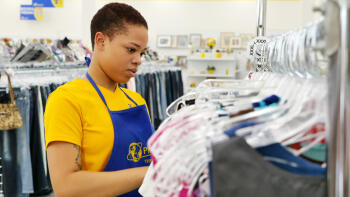"Thrifting" is no longer just for the thrifty.
The growth of the resale industry has increased significantly over recent years. Forty percent of 18 to 24-year-olds shopped resale in 2017. With more than 25,000 consignment, resale, and not-for-profit thrift shops currently operating in the United States, secondhand consumers have plenty of options to choose from.
Stigma Shift
Experts believe the growth of the resale industry is due in part to a change in attitudes towards buying used, specifically during the Great Recession that started in 2008. During this time period, many people were forced to adopt measures of frugality, which may have helped frame thrift shopping as sensible rather than desperate, lessening any stigma attached to it.
In addition, consumers are more aware now than ever of the ethical and environmental impacts associated with their purchased goods and services. According to thredUP, 77 percent of millennials prefer to buy from environmentally-conscious brands. Since eco-fashion is often out of millennial's budgets, the next best thing is to use those handy thrifting skills.
Thrift shopping complements larger social trends, as well. For those who want to lead eco-friendly lifestyles, buying secondhand is the most straightforward means of applying the virtues of reuse and recycling to fashion. The Do-It-Yourself, or "DIY," movement encourages resourcefulness instead of purchasing new. Thrift shops are natural allies of the DIY-er, serving as a valuable and affordable source for the materials needed for these projects.

For fashionistas around the world, one-of-a-kind pieces are essential to every outfit. More often than not, cool and trendy items usually come with a steep price and can break the bank. This is the ultimate discouragement for fashionistas on a budget. Fortunately, thrift stores offer the element of unique, trendy, and quality clothing at a lower cost than retail stores.
Like most things in the 21st century, thrift shopping can be done online through digital consignment shops like The RealReal, thredUP, and Poshmark. Although, 60 percent of consumers say they prefer to buy secondhand goods in person.
Fast Fashion vs. Consumer Responsibility
While the demand for secondhand outlets may have increased as a result of more recent cultural shifts, the supply of clothing to fill the racks is not necessarily dwindling as a result. Americans buy more clothes now than ever, in large part because fashion is much cheaper today than in the past. The more we purchase, the faster we need to make room in our closets, meaning the more we need to get rid of as each season passes.
This "fast fashion" model sounds like a great concept, but it is extremely dangerous to the environment. The production of clothing uses a tremendous amount of resources. For example, 700 gallons of water is used to make just one cotton T-shirt! Because the quality of the clothing isn't the best, and consumers are purchasing clothes at a faster rate, an expanded amount of textiles end up in the landfill each year. In fact, 26 billion pounds of clothing and textiles end up in the landfill each year, yet about 95 percent of those could be reused or recycled.
In addition to purchasing retail responsibly, thrift shopping is a great antidote to this problem. Donating to and buying from thrift stores extends the lifespan of our clothes and keeps them out of the landfill. Imagine the progress we could make if every person in the United States donated just one item or purchased one item from a thrift store each year, instead of throwing them out or shopping retail.

Planet Aid's thrift store in Maryland, the Planet Aid Thrift Center, supports our development projects abroad (as do the clothes dropped in our yellow bins throughout the country). Goodwill uses proceeds from its stores for job training. Salvation Army supports a wide range of domestic and international programs. There is also a wide range of independent stores throughout the country that supports their own local causes.
So grab a couple bucks, go forth and, in the wise words of Macklemore, "pop some tags" at your local thrift store.
